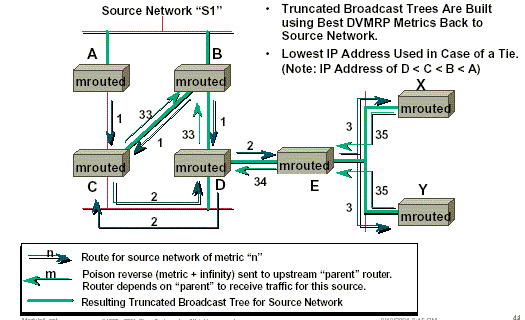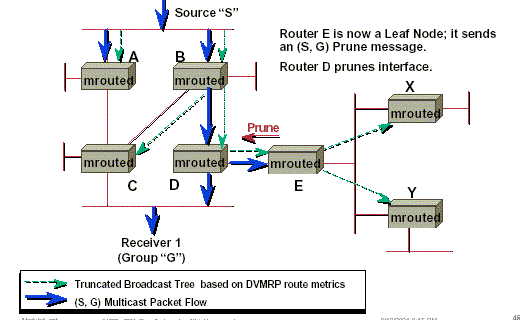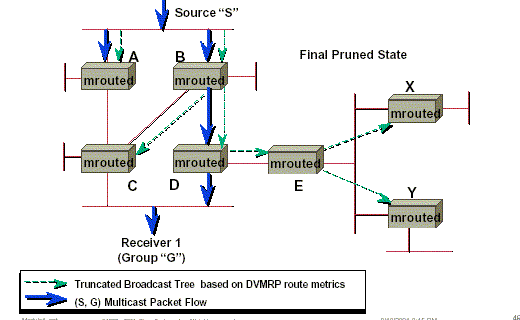


DMVRP
Source Trees
DVMRP builds its Source Trees using the concept of a 'Truncated Broadcast Tree' (TBT). The basic definition is tha the TBT for a source subnet 'S1' represent a shortest path spanning tree rooted at subnet 'S1' to all other routers in the network.

In DVMRP, the abstract notion of the TBT for all subnetworks are build by the exchange of periodic DVMRP routing updates between all DVMRP routers in the network. Similar to its unicast cousin RIPv2, DVMRP updates contain network prefixes/masks along with route metrics (in hop count) that describe the cost of reaching a particular subnet in the network. Unlike RIPv2, however, a downstream DVMRP router makes use of a special Poison-Reverse advertisment to signal an upstream router that this link is on the TBT for source subnet S1. This PR is created by adding 32 to the advertised metric and sending back to the upstream router.
In the above example, DVMRP updates are being exvhange for the source network S1. Routers A and B both advertise a metric of 1 to reach network S1 to routers C and D. In the case of router D, the advertisement from B is the best (only) route to source nrtwork S1 which causes router D to send back a PR adverisement (metric=33) to B. This tells router B that router D is on the TBT for source network S1. In the case of router C, it received an advertisement from both A and Bwith the same metric. It breaks ties using the lowest IP address and therefore sends a PR advertisement back to router B. B now knows that it has two branches of the TBT, one to router C and tthe other to router D. These DVMRP updtaes flow throughout the entire network causing each router to send PR advertisement to its upstream DVMRP neighbour on the TBT for source network S1.
The result of convergence of all the PR advertisements, the S1 TBT is shown below,

This is a minimum spanning tree that is rooted at the source network S1 and psans all routers in the network. If a multicast source were to now go active in the network S1, the DVMRP routers in the network will initially flood this source traffic down the S1 TBT.
Should another Source network exist, eg S2, we would need a TBT for S2, which is shown below.

This TBT would also be created by the exchange of DVMRP route updates and by PR advertisements send by all routers in the network towards network S2. It is important to remember that these TBT's simply exist in the form of PR advertisements in the DVMRP routing tables of the routers in the network and as such, these is one TBT for every source network in the DVMRP network.
This means that the use of TBT's require separate DVMRP routing informmation to be exchanged throughout the entire network. Also, as DVMRP uses a RIP model, is has all the problems associated with a distance-vector protocol including count to infinitity, holdown, periodic updates etc. As such, it is not as robust nor scalable as some other protocols available.
Example of Flood & Prune
In the following example we see source S has began to transmit multicast traffic to a group G. Initially, the traffic, shown by the solid arrows, is flooded to all routers in the network down the Truncated Broadcast Tree and is reaching Receiver 1.

As Router C is a leaf node on the TBT, and has no need for traffic, it sends a DVMRP (S,G) prune message up the TBT to router B to shutoff the unwanted flow of traffic.

Router B receives this (S,G) Prune message and shuts off the flow of (S,G) traffic to router C.
This is also true of routers X and Y, whichalso send (S,G) Prune messages up to the Router E.

Once router E has received (S,G) Prune messages from all DVMRP neighbours on the subnet it prunes the Ethernet interface connected to router X and Y.
At this point, all of router E's downstream interfaces on the TBT have been rpuned and it no longer has any need for the (S,G) traffic. As such, it too sends an (S,G) Prune up to Router D on the TBT.

When router D receives this Prune message, it prunes the interface and shuts off the flow of (S,G) traffic to router E.
This leaves the following TBT from which multicast traffic will flow,

However, as DVMRP is a 'flood and prune' protocol, these pruned brances of the TBT will time out and (S,G) traffic will once again flood down all branches of the TBT. This will again trigger the sending (S,G) Prune messages up the TBT to prune unwanted traffic.
| Wed, 23 July, 2003 13:07 |
Room D14, High Energy Particle Physics, Dept. of Physics & Astronomy, UCL, Gower St, London, WC1E 6BT